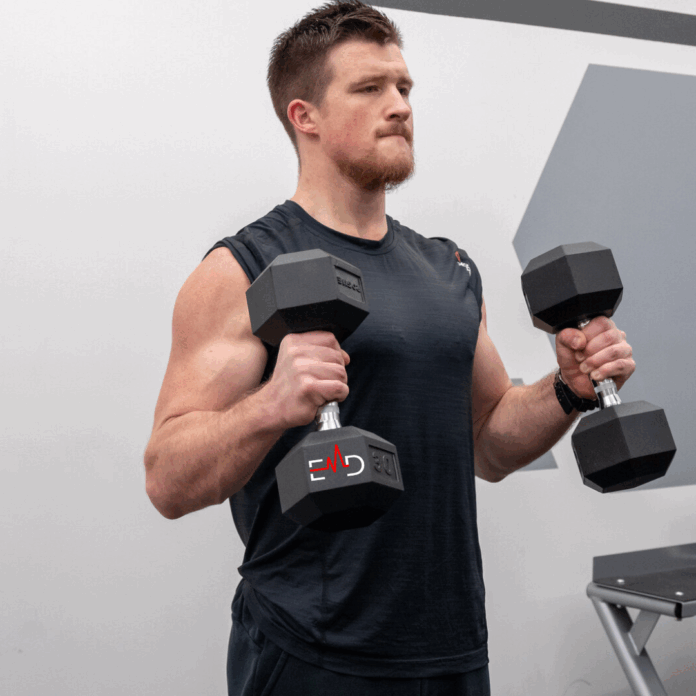Exercise Daily – Strong, well-defined shoulders are aesthetically pleasing and crucial for upper body strength and functionality. Dumbbells are versatile and affordable exercise equipment to help you achieve your shoulder-sculpting goals. This comprehensive guide will introduce you to the top dumbbell exercises for building powerful shoulders, providing detailed instructions and tips for maximizing their effectiveness.
The Anatomy of the Shoulders
Before delving into the exercises, let’s briefly explore the anatomy of the shoulders. The shoulder joint is a complex ball-and-socket articulation that connects the upper arm bone (humerus) to the shoulder blade (scapula). The muscles surrounding the shoulder joint are collectively known as the deltoids, which are responsible for shoulder movement and stability.
The deltoids are divided into three heads:
Anterior deltoid: This front head is responsible for raising the arm forward.
Middle deltoid: This middle head is responsible for raising the arm out to the side.
Posterior deltoid: This rear head is responsible for raising the arm backward.
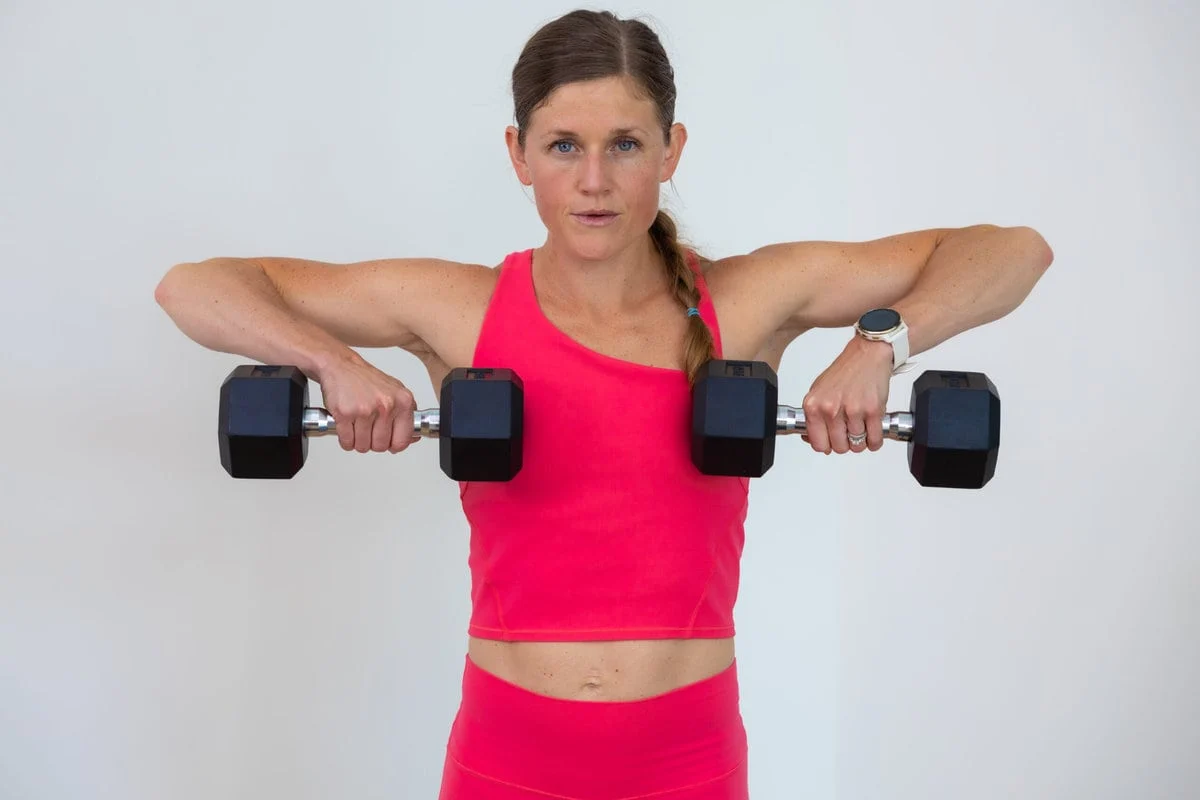
Dumbbell Exercises for Sculpting Powerful Shoulders
Now, let’s dive into the dumbbell exercises that will help you sculpt powerful shoulders:
1. Dumbbell Shoulder Press
The dumbbell shoulder press is a compound exercise that targets all three heads of the deltoids, making it an excellent starting point for shoulder development.
Instructions:
- Stand with feet shoulder-width apart, holding a dumbbell in each hand at shoulder height, palms facing forward.
- Press the dumbbells overhead until your arms are straight, then slowly lower them back to the starting position.
2. Dumbbell Front Raise
The dumbbell front raise targets the anterior deltoids, giving you those defined front shoulders.
Instructions:
- Stand with feet shoulder-width apart, holding a dumbbell in each hand with palms facing inward.
- Raise your arms directly before you until they are parallel to the floor, then slowly lower them back to the starting position.
3. Dumbbell Lateral Raise
The dumbbell lateral raise isolates the middle deltoids, creating that desirable shoulder width.
Instructions:
- Stand with feet shoulder-width apart, holding a dumbbell in each hand with palms facing down.
- Raise your arms to the sides until they are parallel to the floor, keeping your elbows slightly bent, then slowly lowering them back to the starting position.
4. Dumbbell Bent-Over Raise
The dumbbell bent-over raise primarily targets the posterior deltoids, strengthening the back of your shoulders.
Instructions:
- Bend forward at the waist, keeping your back straight and core engaged. Hold a dumbbell in each hand with palms facing inward.
- Raise your arms to the sides until they are parallel to the floor, keeping your elbows slightly bent, then slowly lowering them back to the starting position.
5. Dumbbell Upright Row
The dumbbell upright row targets the trapezius muscles, contributing to overall shoulder strength and posture.
Instructions:
- Stand with feet shoulder-width apart, holding a dumbbell in each hand with palms facing inward.
- Raise your arms directly in front of you until they are parallel to the floor, keeping your elbows close to your body, then slowly lower them back to the starting position.
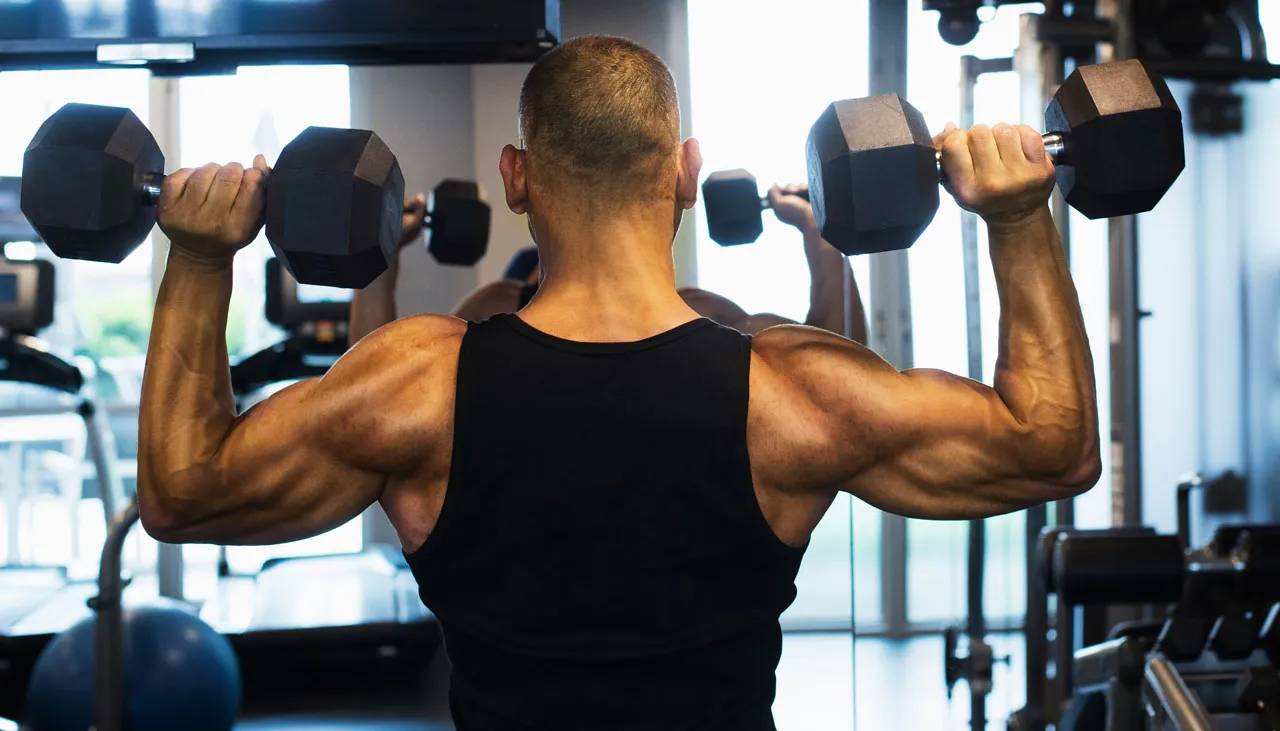
6. Dumbbell Shoulder Shrugs
The dumbbell shoulder shrug is a great exercise for working the trapezius muscles.
To do the dumbbell shoulder shrug, stand with your feet shoulder-width apart and your knees slightly bent. Hold a dumbbell in each hand with your palms facing each other. Shrug your shoulders up towards your ears. Lower your shoulders back down to your starting position.
Here are some tips for performing the dumbbell shoulder shrug:
- Keep your core engaged throughout the entire exercise.
- Use a weight that is challenging but allows you to maintain proper form.
- Don’t let your shoulders hunch forward.
- Breathe out as you shrug your shoulders up and in as you lower them down.
7. One-Arm Dumbbell Swing
The one-arm dumbbell swing works the hamstrings, glutes, and lower back.
To do the one-arm dumbbell swing, stand with your feet shoulder-width apart and your knees slightly bent. Hold a dumbbell in one hand with your palm facing forward. Swing the dumbbell back between your legs and then up towards your chest. Return to the starting position and repeat.
Here are some tips for performing the one-arm dumbbell swing:
- Keep your core engaged throughout the entire exercise.
- Use a weight that is challenging but allows you to maintain proper form.
- Don’t let your back arch.
- Breathe out as you swing the dumbbell up and in as you swing it back down.
8. Spellcaster
The spellcaster is a great exercise for working the core, shoulders, and arms.
To do the spellcaster, stand with your feet shoulder-width apart and your knees slightly bent. Hold a dumbbell in each hand with your palms facing each other. Twist your body to the right and raise the dumbbell in your right hand towards your chest. Twist your body to the left and raise the dumbbell in your left hand towards your chest. Return to the starting position and repeat.
Here are some tips for performing the spellcaster:
- Keep your core engaged throughout the entire exercise.
- Use a weight that is challenging but allows you to maintain proper form.
- Don’t let your back arch.
- Breathe out as you twist your body to the right and in as you twist your body to the left.
9. See Saw Press
The see-saw press works the chest, shoulders, and triceps.
To see-saw press, lie on a bench with your feet flat on the floor and your knees bent. Hold a dumbbell in each hand with your palms facing forward. Press the dumbbells up over your chest until your arms are fully extended. Lower the dumbbells to one side of your chest, then the other. Repeat.
Here are some tips for performing the see-saw press:
- Keep your core engaged throughout the entire exercise.
- Use a weight that is challenging but allows you to maintain proper form.
- Don’t let your elbows flare out to the sides.
- Breathe out as you press the dumbbells up and in as you lower them down.
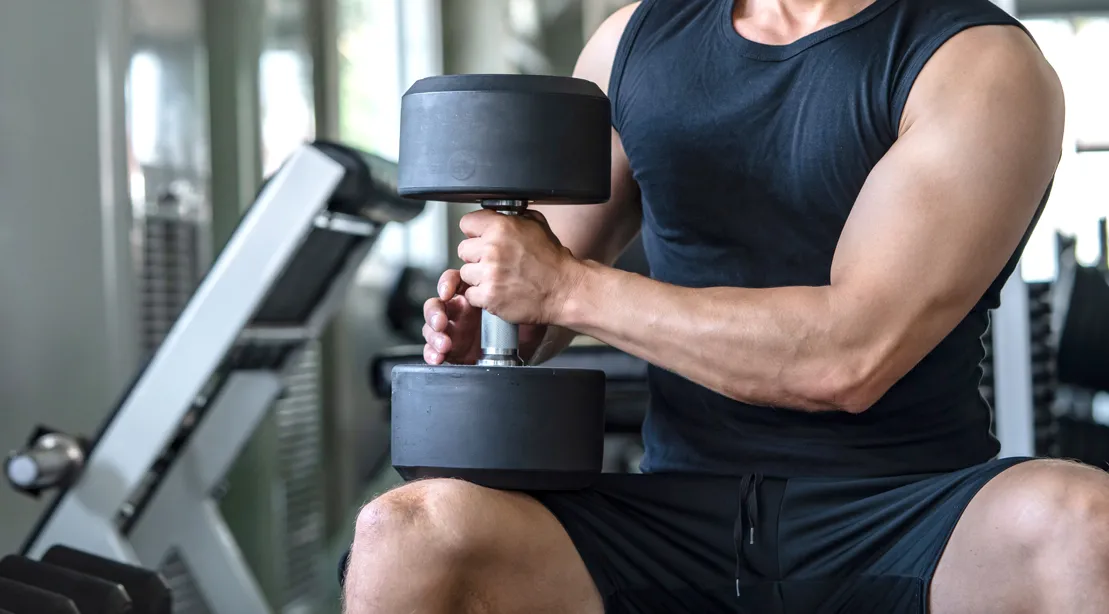
Maximizing Exercise Effectiveness by
Warm up before each workout.
A proper warm-up will increase blood flow to your muscles, improve your range of motion, and reduce the risk of injury. Before your shoulder workout, perform 5-10 minutes of light cardio and dynamic stretches.
Cool down after each workout.
A cool-down allows your heart rate and blood pressure to gradually return to normal, promoting muscle recovery and reducing soreness. Perform 5-10 minutes of static stretches after your shoulder workout.
Maintain proper posture
Throughout your exercises, maintain good posture by keeping your back straight, your core engaged, and your shoulders back and relaxed.
Breathe correctly
Coordinate your breathing with your movements. Exhale during the exertion phase of each exercise and inhale during the recovery phase.
Track your progress
Record your workouts, including the exercises you performed, the weights you used, and the number of sets and repetitions you completed. This will help you track your progress and adjust your routine as needed.
Seek professional guidance
If you are new to strength training or have concerns about your form or technique, consider consulting a certified personal trainer or fitness instructor. They can provide personalized instruction and help you develop a safe and effective workout plan.
Fuel your body properly.
Nutrition plays a crucial role in muscle growth and recovery. Ensure you consume a balanced diet with adequate protein, carbohydrates, and healthy fats to support your training.
Prioritize rest and recovery.
Adequate rest is essential for muscle growth and repair. Aim for 7-8 hours of sleep each night and allow sufficient rest between workouts to prevent overtraining.
Incorporate variety
Incorporate different variations of dumbbell shoulder exercises into your routine to keep your muscles challenged and prevent plateaus. Try changing the grip, the angle of the movement, or the tempo to target your muscles from different angles and promote continuous progress.
Enjoy the process
Stay motivated and engaged by finding exercises you enjoy and setting realistic goals. Celebrate your achievements along the way to maintain motivation and keep yourself on track.
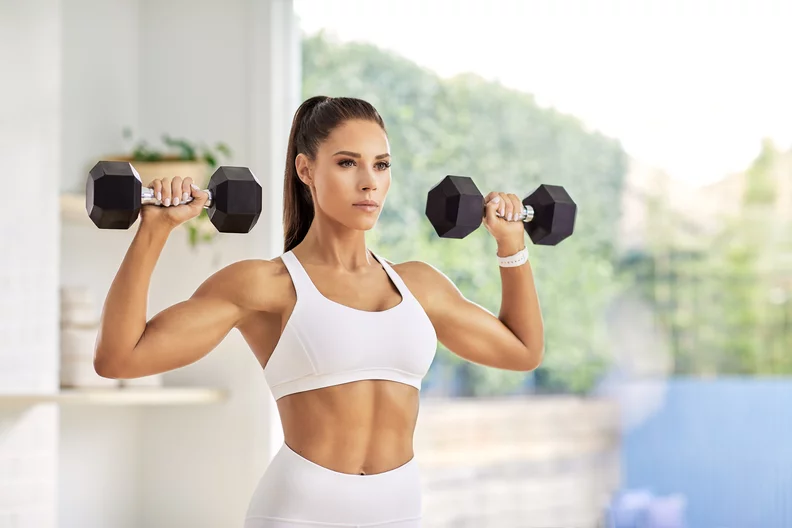
Conclusion
Dumbbells offer a versatile and effective way to sculpt powerful shoulders. Incorporating the abovementioned exercises into your workout routine allows you to develop well-defined, strong, and functional shoulders to enhance your overall physique and athletic performance. Remember to prioritize proper form, maintain a consistent training schedule, and gradually increase the challenge as you progress. You can achieve the sculpted shoulders you desire with dedication and consistent effort.
FAQs about sculpting powerful shoulders with dumbbells
Q: How often should I train my shoulders with dumbbells?
Aim to train your shoulders with dumbbells 2-3 times weekly for optimal results, allowing sufficient rest and recovery time between workouts. Overtraining can lead to fatigue, decreased performance, and increased risk of injury.
Q: How many sets and reps should I perform for each exercise?
A general guideline for shoulder training with dumbbells is to perform 3-4 sets of 8-12 repetitions for each exercise. This rep range allows for muscle growth and strength development while minimizing the risk of overtraining.
Q: Should I use heavy or light weights?
The weight you choose depends on your fitness level and goals. Start with a lighter weight that allows you to maintain proper form throughout the entire set. As you get stronger, gradually increase the weight to challenge your muscles and promote further growth.
Q: What are some common mistakes to avoid when training shoulders with dumbbells?
Common mistakes to avoid include swinging the weights, using excessive momentum, and sacrificing form for heavier weights. Focus on controlled movements, engage your core throughout each exercise, and prioritize proper form over lifting the heaviest weight possible.
Q: How can I incorporate dumbbell shoulder exercises into my workout routine?
If you already have a workout routine, you can incorporate dumbbell shoulder exercises into your upper body days or add a dedicated shoulder-focused workout. Start with 2-3 exercises, gradually adding more as you get stronger. Listen to your body and adjust the intensity and volume as needed.

